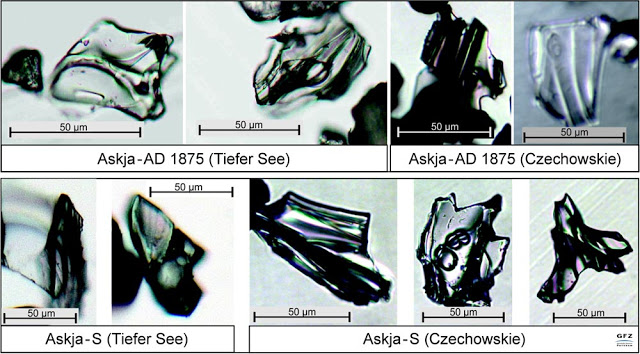
Traces of volcanic ash originating from islandic volcanoes have been found in the sediments of Laker Tiefer See in the Nossentiner-Schwinzer Heide natural park in Mecklenburg-Vorpommern. This allows to more precisely date climate changes of the last 11500 years. An international team of geoscientists lead by the GFZ German Research Centre for Geosciences detected traces of in total eight volcanic eruptions on Island of which six could be precisely identified. The oldest eruption occurred 11400 years ago and the youngest from AD 1875 has been also described in historical documents.
Seasonally laminated lake sediments represent ideal geoarchives for reconstructing natural climate variability in the past. Achim Brauer from the Research Centre for Geosciences explained the particular importance of the identified volcanic ash deposits: “Particles of three of the volcanic ashes detected in Lake Tiefer See have been also found 500 km further East in a lake in Poland. For the first time, this allows to synchronize both sediment archives to the year precise, which enables us to decipher even subtle regional differences of climate changes in the past. This information, in turn, provides the chance to better anticipate regional aspects of future climate change.”
The particular challenge of this approach was the fact that volcanic ash was not deposited as visible layers, but only as a few tiny volcanic glass particles scattered in the lake sediments. “These small glass particles commonly are smaller than 50 micrometer”, explained GFZ-scientist Sabine Wulf. “We applied a novel combination of chemical and microscopic methods to detect these fine traces in the lake sediments and to separate them for further analyses.” Geochemical analyses of individual glass shards and their comparison with volcanic ash from the source region on Island ideally allows to precisely tracing back the corresponding volcanic eruption. Moreover, this approach allows reconstructing the distribution of volcanic ash clouds from eruptions in the past over large areas and thus provides new insights into past wind conditions.
Reference:
Sabine Wulf et al. Holocene tephrostratigraphy of varved sediment records from Lakes Tiefer See (NE Germany) and Czechowskie (N Poland), Quaternary Science Reviews (2016). DOI: 10.1016/j.quascirev.2015.11.007
Note: The above post is reprinted from materials provided by Helmholtz Association of German Research Centres.









